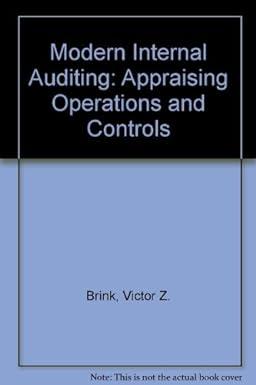Question
Question Below mentioned are the internal controls of The Syngenta Company, a pesticide producer, intended for the billing and recording of receivables from debtors: a)
Question
Below mentioned are the internal controls of The Syngenta Company, a pesticide producer, intended for the billing and recording of receivables from debtors: a) The assistant in the order section receives the purchase demand form the client and the assistant then produces a pre-numbered sales demand form. In this sales demand form, Clients name and address, account number, the number and description of products demanded is mentioned. Then the clients purchase demand form is attached to this sales demand form being prepared. b) Credit section receives this sales demand form for credit authorization. The credit section makes the estimates for the billing amounts of the demands from the clients for whom the credit restrictions are placed. Sanction of the credit is notified on the sales demand form after a thorough examination. c) Afterwards, the billing section receives the sales demand form, wherein a computerised clients bill is generated by the assistant. And computerised calculation is carried out by multiplying the product quantity with price per unit to arrive at total bill amount. The assistant in the billing section decides the per unit price of the product from an already prepared list which includes the predetermined prices for each product. Several copies of the bill are prepared for each of concerned section/party i.e. Client copy, Sales section copy (for their record), file copy, & delivery section copy (as delivery order). As part of the billing practices, as well as bills of lading are being prepared as carbon copy by-products. d) Later on, the delivery section receives its copy of bill (delivery order) and bills of lading for delivery of products. Copies of the bills of lading are sent back to the billing section after the shipment of the products. The delivery section retains its copy of the bill and is filed. e) In the billing section, the clients copy of bill is attached with one copy of bills of lading and then both copies are emailed to the client. Sales demand form, along with the other copy of bill of lading, is attached to the bill file copy and filed in bill numerical order. f) The accounting records are updated daily, as the computerised bills are being generated and also the transactions are also saved in an electronic file. For hard copy of the records, all journals and ledgers are reproduced along with the summary of report being generated. g) The internal auditor from time to time tracks a sample of sales demands all the way through the system to the journal and ledgers to test both the procedures and euro amounts. Different procedures being performed are the comparison of control totals with output, recalculation of the bills and refooting journal, and tracking of the totals to the general ledger and master file. h) The Director Finance ensures, that sales are properly aggregated and also ensures the completeness and accuracy of sales related footnotes disclosures, through financial statements review. 3/4 Required: i. By going through the above case study, identify and list down the internal controls over sales for each of the seven transaction related audit objectives. (20 Points) ii. Considering each of the internal controls identified in part (i), you are required to list down useful test of control to ensure the effectiveness of the control. (20 Points) iii. Considering each of the seven transaction related audit objectives for sales, you are required to list down appropriate substantive tests of transactions audit procedures, in view of internal controls.
Step by Step Solution
There are 3 Steps involved in it
Step: 1

Get Instant Access to Expert-Tailored Solutions
See step-by-step solutions with expert insights and AI powered tools for academic success
Step: 2

Step: 3

Ace Your Homework with AI
Get the answers you need in no time with our AI-driven, step-by-step assistance
Get Started


